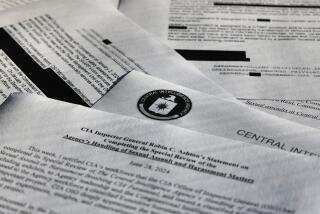Torture report describes key 9/11 figure facing off with interrogators
Reporting from WASHINGTON — Less than two hours after self-avowed Sept. 11 mastermind Khalid Shaikh Mohammed was captured, the chief of interrogations of a new CIA detention site in Afghanistan emailed Washington with this subject line: “Let’s roll with the new guy.”
For the next 3 1/2 years, until his transfer to the prison at Guantanamo Bay, Cuba, what Mohammed told his CIA interrogators — and more often what he refused to tell them —- yielded 831 intelligence reports, nearly 15% of all such CIA missives sent during those crucial first years after the 2001 terrorist attacks that killed about 3,000 Americans.
By far the most high-value accused Sept. 11 conspirator captured by the U.S., he was also subjected to the most torture by CIA interrogators, according to a Senate Intelligence Committee summary about the agency’s brutal interrogation program.
Mohammed was waterboarded 183 times, received “rectal hydration,” was kept awake for 7 1/2 days, was made to stand for hours with his hands above his head and was put in a horizontal stress position unapproved by CIA headquarters, the Senate report states.
In its rebuttal, the CIA insisted that the information Mohammed provided under what it calls enhanced interrogation techniques led to the arrest of other suspects, confirmed information about future plots and provided a deeper understanding of the inner workings of Al Qaeda.
But the Senate report raises questions about the value of the information obtained from Mohammed during his torture and offers new details about how he and his interrogators faced off during his years in CIA custody.
“A significant amount” of what Mohammed told the agency during these interrogations “was later identified as fabricated,” the report concludes, relying on the CIA’s internal assessments at the time of the interrogations. Other times he merely confirmed intelligence already known to the United States or outright lied, later recanting his stories.
“KSM Guarding Most Sensitive Information,” the agency titled one of its memos to then-President George W. Bush and other Washington officials. “Precious Truths, Surrounded by a Bodyguard of Lies,” read another.
Mohammed today is the chief defendant among five accused Sept. 11 plotters who could face the death penalty in a U.S. military prosecution at Guantanamo.
From the start, he was the CIA’s most-prized detainee. Dubbed KSM by U.S. officials, he boasted that he cut the throat of Wall Street Journal reporter Daniel Pearl, plotted follow-up attacks after Sept. 11, and enjoyed a right-hand seat next to Al Qaeda leader Osama bin Laden.
They had high hopes for what he could tell them about imminent threats to the U.S., and wasted little time.
In that first email upon Mohammed’s arrest on March 1, 2003, the CIA interrogation chief requested permission to “press KSM for threat info right away.” He was taken first to a rundown brick factory outside Kabul, known as the Salt Pit, which became one of the CIA’s most notorious “black sites,” or secret prisons.
CIA records state that within “minutes” they were slapping him in the face and stomach, stripping him naked, dousing him with water.
For a brief period in the initial days, they adopted a “softer Mr. Rogers” approach after interrogators concluded the harsh treatment caused Mohammed to “clam up.” Officials reported that a “more cooperative” Mohammed gave them the “best session to date.” But they later discovered he had been lying, leading the CIA to wrongly detain “two innocent individuals.”
The CIA quickly turned to “enhanced interrogation techniques,” particularly waterboarding, which involved forcing large amounts of water down his mouth and nose to simulate drowning. That was the “big stick,” an on-site medical officer wrote. “HQ was more or less demanding that it be used early and often.”
During waterboarding, Mohammed’s stomach was distended from so much water that medical staff was “not concerned about regurgitated gastric acid damaging” his esophagus. They continued waterboarding him nearly every day in those early weeks — four times in one 14-hour period, five times in another 25 hours, the report shows.
But Mohammed at times seemed to take pride in his ability to withstand it. During the procedure, he would sometimes point two index fingers upward as the waterboarding reached the time limit permitted under agency guidelines, which the CIA took as a signal that he had figured out when sessions would be over. He seemed “alert,” though he “yelled and twisted” on the table. He also, they said, “appeared resigned to tolerating the board.”
Eventually he started talking. But much of what he said appeared to be lies or fabrications, according to CIA assessments.
“KSM will selectively lie, provide partial truths, and misdirect when he believes he will not be found out and held accountable,” read one CIA assessment. Other missives complained about Mohammed intentionally misidentifying photographs and misleading agents about phone numbers he was asked about.
Regarding information about Bin Laden and his family, Mohammed gave conflicting reports and offered only “limited” information.
On May 7, 2003, his questioners concluded that Mohammed “consistently wavers” on issues of Bin Laden’s location and protectors, and his information “conveniently” lacks “sufficient detail [to be] actionable intelligence.”
Under torture, Mohammed said nothing about a plot to bomb U.S. targets in Pakistan, including hotels near the airport and beach in Karachi. Only after being shown photographs of two of the accused plotters in custody did Mohammed offer information about the plan.
His delay in telling the truth infuriated interrogators, who complained that if the pair had not been captured in time, Mohammed’s omission might “well have cost American lives.”
“Simply put, KSM had every opportunity to come clean on this threat and, from our optic, he deliberately withheld the information until he was confronted with the evidence that we already knew about it,” read a CIA cable.
When asked about a plan to use airplanes to attack the West Coast, including the former Library Tower in downtown Los Angeles, Mohammed at first denied the plot existed.
Eventually, he told interrogators that he was aware of the scheme. But again, he apparently did so only after learning one of the plotters already had been captured.
In its rebuttal to the Senate report, the CIA insisted that its interrogation techniques elicited helpful information from Mohammed.
For example, he helped decode messages intercepted by the U.S. and its allies, the CIA said. “Perfume,” he told them, meant conventional weapons and “animals” meant vehicles.
In a case involving a plot to attack London’s Heathrow Airport, Mohammed acknowledged he had ordered surveillance and the collection of flight timetables. “KSM was responsible for helping us identify two potential operatives” in the plot, the agency concluded in its rebuttal.
Yet in most of its assessments made during his interrogation, CIA analysts complained repeatedly that Mohammed, even after being subjected to torture, would disclose information only about plots that he was asked about.
When the two accused plotters of the Karachi attack revealed details about the Heathrow plan that Mohammed had not previously disclosed, an exasperated CIA official wrote: “OK, that’s it ... yet again he lies and ONLY ADMITS details when he knows we know them from someone else.”
More to Read
Sign up for Essential California
The most important California stories and recommendations in your inbox every morning.
You may occasionally receive promotional content from the Los Angeles Times.











